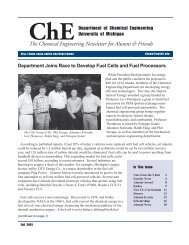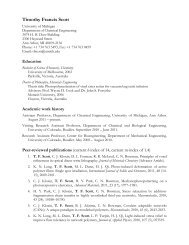Making Oil at Warp Speed - Chemical Engineering - University of ...
Making Oil at Warp Speed - Chemical Engineering - University of ...
Making Oil at Warp Speed - Chemical Engineering - University of ...
Create successful ePaper yourself
Turn your PDF publications into a flip-book with our unique Google optimized e-Paper software.
Arbor<br />
<strong>at</strong> the <strong>University</strong>, completing his PhD<br />
in 1952 under the direction <strong>of</strong> Pr<strong>of</strong>essor<br />
J.C. Brier. After receiving his doctoral<br />
degree, Stuart was a faculty member in<br />
the department for many years, serving<br />
as chair <strong>of</strong> the department from 1962-<br />
1967.<br />
For over half a century he has made<br />
numerous contributions in the fields<br />
<strong>of</strong> combustion, he<strong>at</strong> transfer and fluid<br />
dynamics. He has received numerous<br />
awards from n<strong>at</strong>ional pr<strong>of</strong>essional<br />
groups, including the American Institute<br />
<strong>of</strong> <strong>Chemical</strong> <strong>Engineering</strong>, <strong>of</strong> which he<br />
served as president in 1966. In 1974, he<br />
was elected to the N<strong>at</strong>ional Academy <strong>of</strong><br />
<strong>Engineering</strong>.<br />
Stuart’s former students<br />
(from left to right): Warren<br />
Seider (PhD ’66) , Marty<br />
Gluckstein (PhD ’57), Irv<br />
Miller (PhD ’60), Jim Wilkes<br />
(PhD ’63), David Hellums<br />
(PhD ’61), Stuart, Mark<br />
Strenger (Penn), Humbert<br />
Chu (Penn), Christina Chan<br />
(Penn), John Chen (PhD<br />
’61), Lance Collins (Penn),<br />
and Vicki Booker (Penn).<br />
and appreci<strong>at</strong>ion for celebr<strong>at</strong>ing this<br />
special occasion with so many family,<br />
friends, former doctoral students, and<br />
colleagues.<br />
Thanks to Warren Seider (MSE ’63; PhD,<br />
’66) for this article.<br />
Product Design—A New Option<br />
K<strong>at</strong>hryn Siuniak and Jenny Ou introduce their team’s new product,<br />
Blue <strong>Oil</strong>—a non-petroleum-based oil.<br />
The process design course has long<br />
been an important part <strong>of</strong> Michigan’s<br />
chemical engineering curriculum.<br />
However, until recently, product design<br />
was not part <strong>of</strong> th<strong>at</strong> curriculum. In<br />
2008, Lecturer Barry Barkel began<br />
developing and teaching a yearlong<br />
product design course. “We knew for<br />
some time we needed to <strong>of</strong>fer a product<br />
design course,” says Barry. “The<br />
problems associ<strong>at</strong>ed with identifying<br />
the right form<strong>at</strong> for a course, to make<br />
its relevance equal to process design,<br />
delayed its introduction.”<br />
Students enroll in the new course<br />
for two consecutive terms. During<br />
the first term, they learn the basic<br />
principles <strong>of</strong> product design and the<br />
required technologies their team will<br />
use for its projects. The students begin<br />
by conducting a market analysis for<br />
the product and eventually cre<strong>at</strong>e an<br />
overall research and development plan<br />
for the project, covering all aspects<br />
th<strong>at</strong> must be investig<strong>at</strong>ed. In the<br />
second term, the students learn the<br />
principles <strong>of</strong> directed research and<br />
economic analysis, and are required<br />
to implement their research<br />
and development<br />
plans in the lab.<br />
Because <strong>of</strong> limit<strong>at</strong>ions<br />
on the lab space,<br />
the class is currently<br />
limited to 15 students.<br />
They are divided up<br />
into three teams, each<br />
working on different<br />
projects. “There are<br />
some r<strong>at</strong>her strong<br />
limit<strong>at</strong>ions for the projects<br />
we can use.” Barry<br />
points out. “We can’t do projects th<strong>at</strong><br />
require expensive equipment, rare<br />
raw m<strong>at</strong>erials, or dangerous reactions.<br />
Nevertheless, we are able to find projects<br />
th<strong>at</strong> require all the elements th<strong>at</strong><br />
appear in industrial settings.”<br />
The labs are open to the students<br />
24/7. They must schedule their own<br />
work and order their own m<strong>at</strong>erials.<br />
They learn real-world lessons th<strong>at</strong> are<br />
not included in the lectures such as,<br />
under certain conditions, a kitchen<br />
blender can serve as a substitute for a<br />
homogenizer; m<strong>at</strong>erial delivery d<strong>at</strong>es<br />
are as important as order d<strong>at</strong>es; regul<strong>at</strong>ory<br />
requirements such as FDA’s can<br />
control your whole development plan;<br />
and th<strong>at</strong>, even though many experiments<br />
don’t work, you can still learn<br />
something from them.<br />
So far students have designed and<br />
developed a blueberry sports drink,<br />
a blue lipstick and adhesive for use<br />
in packaging, liquid dish soap, and a<br />
non-petroleum-based equivalent to<br />
3-in-One <strong>Oil</strong> (photo above).<br />
C O L L E G E O F E N G I N E E R I N G / CHEMICAL ENGINEERING / w w w . c h e . e n g i n . u m i c h . e d u 5





